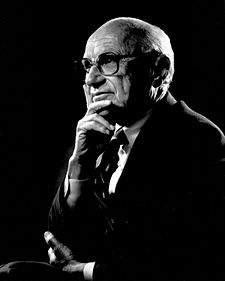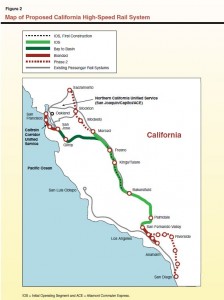The Senate Budget and Fiscal Committee hearing on Feb 6 about using cap and trade funds to fund High-Speed Rail was a lesson in bad government economics.
Roll over Milton Friedman.
Friedman, an American economist, statistician, and writer who taught at the University of Chicago for more than three decades, once said that there is no such thing as different schools of economics; there is only good economics and bad economics.
Gov. Jerry Brown’s 2014-15 budget proposes to spend $850 million from cap-and-trade auction revenue on various projects — including $250 million on the state’s high-speed rail project. However, this would defy the very purpose of cap-and-trade.
Under AB 32, California’s Global Warming Solutions Act of 2006, cap and trade takes money from business owners and manufacturers who produce products, but are deemed “polluters” by the state.
It’s been called a California tax for businesses that emit any greenhouse gas emissions.
With California taxing businesses because they are polluters, shouldn’t that money be used to reduce even more carbon emissions under AB 32, California’s Global Warming Solutions Act?
Climate Change is as serious as… terrorism?
Only two days ago while talking to students in Jakarta, Secretary of State John Kerry called climate change “the world’s largest weapon of mass destruction.” Then he compared global warming to terrorism or nuclear proliferation.
If climate change is as serious a threat as Kerry said, why would the governor divert cap and trade funds, originally designated to fight global warming in California, to build a new high-speed rail system?
The non-partisan Legislative Analyst’s Office has continued to warn about using cap and trade funds for anything other than reducing carbon emissions in the state, in order to reach 1990 levels.
Irony: High-Speed Rail – emitter of greenhouse gasses
In a 2012 report, the LAO said using cap and trade funds for high-speed rail “would not help achieve AB 32’s primary goal.”
Additionally, the LAO said, “High–Speed Rail would initially increase greenhouse gas emissions for many years.”
“As mentioned above, in order to be a valid use of cap–and–trade revenues, programs will need to reduce GHG emissions,” the LAO said. “While the High-Speed Rail Authority has not conducted an analysis to determine the impact that the high–speed rail system will have on GHG emissions in the state, an independent study found that—if the high–speed rail system met its ridership targets and renewable electricity commitments—construction and operation of the system would emit more GHG emissions than it would reduce for approximately the first 30 years. While high–speed rail could reduce GHG emissions in the very long run, given the previously mentioned legal constraints, the fact that it would initially be a net emitter of GHG emissions, could raise legal risks.”
The LAO report said “in order to minimize the economic impact of cap-and-trade, it is important that auction revenues be invested in a way that maximizes GHG emission reductions. Maximizing emission reductions (specifically in the capped sectors) reduces competition for allowances, thereby putting downward pressure on the price of allowances. This, in turn, reduces the overall cost for covered entities to comply with AB 32 and the potential negative economic impacts of the program on consumers, businesses, and ratepayers. It is, however, unclear to what extent the complement of activities proposed by the Governor maximizes GHG emission reductions.”
The LAO warns the Legislature there are legal risks with Brown’s plan to use cap-and-trade auction funds for funding high-speed rail, based on an opinion they received from Legislative Counsel, that said the revenues generated from the CARB’s cap–and–trade auctions are considered “mitigation fee” revenues. The use of these revenues are subject to the Sinclair nexus test.
In the 1996 Sinclair Paint Company v. State Board of Equalization, the California Supreme Court ruled that there are key differences between taxes and fees. The case involved fees authorized by 1991’s AB 2038, which imposed a specific fee on manufacturers of lead-based products, and a detailed funding plan for mitigating lead poisoning.
The Sinclair test requires that a clear nexus must exist between an activity for which a mitigation fee is charged, and the adverse effects related to the activity on which that fee is levied.
Recent LAO research has found that a legitimate use of cap-and-trade revenue under Sinclair includes supplementing existing environmental-related program expenditures with cap-and-trade revenue, as the governor previously proposed.
The LAO believes that mitigation can be viewed broadly, and that nexus can be established with a wide array of climate change programs, but High-Speed Rail is not one of these programs.
The LAO called the use of the cap and trade funds for high-speed rail, “legally risky.”
“Given this legal requirement, the administration’s proposal to fund activities (such as high–speed rail) could be legally risky,” the LAO said. “While the high–speed rail project could eventually help reduce GHG emissions somewhat in the very long run, it would not help achieve AB 32’s primary goal of reducing GHG emissions by 2020.”
More irony from Milton Friedman
“Even the most ardent environmentalist doesn’t really want to stop pollution. If he thinks about it, and doesn’t just talk about it, he wants to have the right amount of pollution. We can’t really afford to eliminate it – not without abandoning all the benefits of technology that we not only enjoy but on which we depend.” ― Milton Friedman, There’s No Such Thing as a Free Lunch



